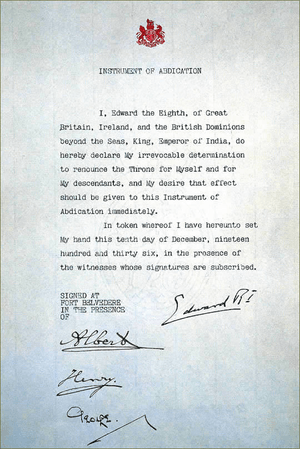His Majesty's Declaration of Abdication Act 1936
|
| |
| Long title | An Act to give effect to His Majesty’s declaration of abdication; and for purposes connected therewith. |
|---|---|
| Citation | 1 Edw. 8 & 1 Geo. 6 c. 3 |
| Introduced by | Stanley Baldwin |
| Territorial extent | United Kingdom; British Empire |
| Dates | |
| Royal Assent | 11 December 1936 |
| Commencement | 11 December 1936 |
| Other legislation | |
| Relates to | Statute of Westminster 1931 |
Status: Current legislation | |
| Text of statute as originally enacted | |
| Text of the His Majesty's Declaration of Abdication Act 1936 as in force today (including any amendments) within the United Kingdom, from the UK Statute Law Database | |

His Majesty's Declaration of Abdication Act 1936 (1 Edw. 8 & 1 Geo. 6 c. 3) was the Act of the Parliament of the United Kingdom that recognised and ratified the abdication of King Edward VIII and passed succession to his brother Prince Albert, Duke of York (who subsequently became King George VI). The act also excluded any possible future descendants of Edward from the line of succession. Edward VIII abdicated in order to marry his lover, Wallis Simpson, after facing opposition from the governments of the United Kingdom and the Dominions.
Procedure and timing
Although Edward VIII had signed a declaration of abdication the previous day—10 December 1936—he remained king until giving Royal Assent to His Majesty's Declaration of Abdication Act, which he did on 11 December.[1]
The act was passed through the British Houses of Parliament in one day, with no amendments. As the Statute of Westminster 1931 stipulated that the line of succession must remain the same throughout the Crown's realms, the governments of some of the British Dominions—Canada, Australia, the Union of South Africa, and New Zealand—requested and gave their permission for the act to become part of the law of their respective realms.
The Canadian parliament later passed the Succession to the Throne Act 1937 to ratify changes to the rules of succession in Canada and ensure consistency with the changes in the rules then in place in the United Kingdom. South Africa passed His Majesty King Edward the Eighth's Abdication Act, 1937, which declared the abdication to have taken effect on 10 December 1936. Australia and New Zealand did not adopt the Statute of Westminster 1931 until the 1940s and did not pass their own legislation. In the Irish Free State, which was independent from the United Kingdom since 1922 and the monarch still had some diplomatic functions, parliament passed the Executive Authority (External Relations) Act 1936, recognising the Duke of York as king from 12 December 1936.
Legal background
The act was necessary for two main reasons.
First, there was no provision in British law for a sovereign to alter their status as sovereign, except through the due process of law. Further, no law exists in Britain that grants to a sovereign the right to choose, on their own authority, voluntarily to alter the scope or to discontinue the term of his or her reign. A close reading of the text of Edward's abdication letter reveals this. Edward VIII did not, in the Instrument of Abdication, solemnise as an accomplished fact, through the instrument, his departure from the throne. The instrument is constructed as a statement of intent: firm intent, but only intent, to attain a future, not yet existent, state of ex-king.
Even in death, it is the laws relating to the succession which operate to recognise through the death a "demise of the Crown", which triggers the operation of other laws that choose and recognise the enthronement of the successor, whose oaths, consecration, and coronation only consecrate and ratify the operation of the existent laws. Thus, to abdicate the sovereign had first formally to resign (through a proper, signed, written instrument of abdication, that of course was witnessed; and in person); then, parliament had to enact legislation which recognised, approved of, and ratified the abdication. Then the king, who at that stage was legally still king, had to give royal assent to the legislation, which then became a law of the United Kingdom and thereby removed the sovereign from the throne. Under the Act of Settlement 1701, the senior descendant of the Sophia, Electress of Hanover, is sovereign in England. The Act of Union 1707 confirmed this for Great Britain. Thus the senior descendant of Sophia who is not excluded by the anti-Catholic provisions of the act is automatically sovereign, whether willingly or not. If the sovereign abdicates, an Act of Parliament is required to give it legal effect.
Second, the act ensured that the throne passed to Prince Albert, Duke of York, and his descendants and that descendants of Edward VIII, if any, would have no claim to the throne and that the Royal Marriages Act 1772 would not apply to them.
Upon King Edward VIII giving his assent to the act (actually, delivered orally on his behalf, as is usual, by Lords Commissioners), he ceased to be king of the United Kingdom of Great Britain and Northern Ireland. The throne immediately passed to his successor, Prince Albert, who was proclaimed King George VI the next day at St. James's Palace, London.
References
- ↑ Text of the His Majesty's Declaration of Abdication Act 1936 as in force today (including any amendments) within the United Kingdom, from the UK Statute Law Database
External links
- Text of the His Majesty's Declaration of Abdication Act 1936 as originally enacted or made within the United Kingdom, from the UK Statute Law Database
- "HIS MAJESTY'S DECLARATION OF ABDICATION BILL". Parliamentary Debates (Hansard). House of Commons of the United Kingdom. 12 December 1936. col. 2199–2221.
| ||||||||||||||||||||||
| ||||||||||||||||||||||||||||||||||
.svg.png)